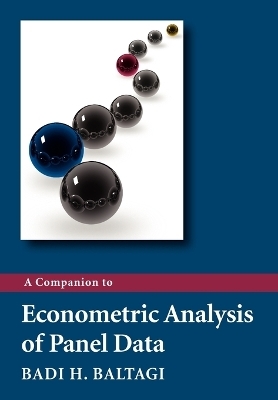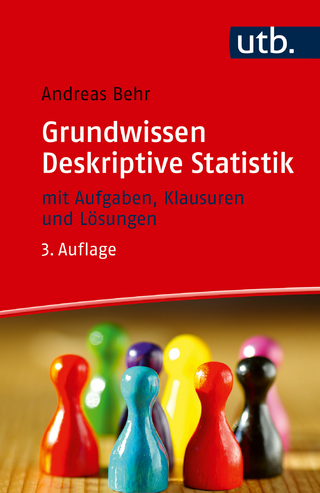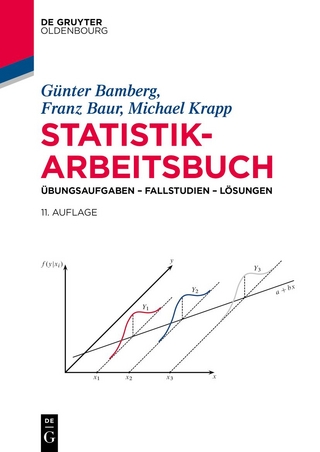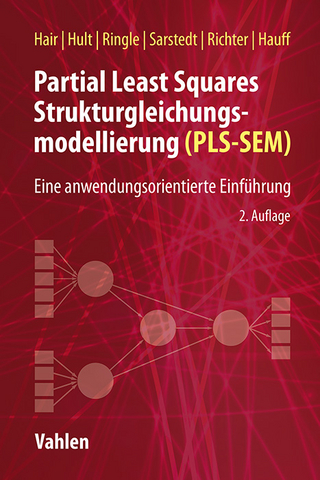
A Companion to Econometric Analysis of Panel Data
John Wiley & Sons Inc (Verlag)
978-0-470-74403-1 (ISBN)
This book is a companion to Baltagi’s (2008) leading graduate econometrics textbook on panel data entitled Econometric Analysis of Panel Data, 4th Edition. The book guides the student of panel data econometrics by solving exercises in a logical and pedagogical manner, helping the reader understand, learn and apply panel data methods. It is also a helpful tool for those who like to learn by solving exercises and running software to replicate empirical studies. It works as a complementary study guide to Baltagi (2008) and also as a stand alone book that builds up the reader’s confidence in working out difficult exercises in panel data econometrics and applying these methods to empirical work.
The exercises start by providing some background information on partitioned regressions and the Frisch-Waugh-Lovell theorem. Then it goes through the basic material on fixed and random effects models in a one-way and two-way error components models: basic estimation, test of hypotheses and prediction. This include maximum likelihood estimation, testing for poolability of the data, testing for the significance of individual and time effects, as well as Hausman's test for correlated effects. It also provides extensions of panel data techniques to serial correlation, spatial correlation, heteroskedasticity, seemingly unrelated regressions, simultaneous equations, dynamic panel models, incomplete panels, measurement error, count panels, rotating panels, limited dependent variables, and non-stationary panels.
Badi H. Baltagi is Distinguished Professor of Economics, and Senior Research Associate at the Center for Policy Research, Syracuse University. He is a fellow of the Journal of Econometrics, a recipient of the Multa and Plura Scripsit Awards from Econometric Theory, and the Journal of Applied Econometrics Distinguished Authors Award.
Preface xi
1 Partitioned Regression and the Frisch–Waugh–Lovell Theorem 1
Exercises
1.1 Partitioned regression 1
1.2 The Frisch–Waugh–Lovell theorem 2
1.3 Residualing the constant 3
1.4 Adding a dummy variable for the ith observation 3
1.5 Computing forecasts and forecast standard errors 4
2 The One-way Error Component Model 9
2.1 The One-way Fixed Effects Model 9
Exercises
2.1 One-way fixed effects regression 10
2.2 OLS and GLS for fixed effects 11
2.3 Testing for fixed effects 12
2.2 The One-way Random Effects Model 12
Exercises
2.4 Variance–covariance matrix of the one-way random effects model 13
2.5 Fuller and Battese (1973) transformation for the one-way random effects model 14
2.6 Unbiased estimates of the variance components: the one-way model 15
2.7 Feasible unbiased estimates of the variance components: the one-way model 16
2.8 Gasoline demand in the OECD 17
2.9 System estimation of the one-way model: OLS versus GLS 22
2.10 GLS is a matrix weighted average of between and within 23
2.11 Efficiency of GLS compared to within and between estimators 24
2.12 Maximum likelihood estimation of the random effects model 25
2.13 Prediction in the one-way random effects model 26
2.14 Mincer wage equation 27
2.15 Bounds for s2 in a one-way random effects model 30
2.16 Heteroskedastic fixed effects models 31
3 The Two-way Error Component Model 35
3.1 The Two-way Fixed Effects Model 35
Exercise
3.1 Two-way fixed effects regression 36
3.2 The Two-way Random Effects Model 38
Exercises
3.2 Variance–covariance matrix of the two-way random effects model 38
3.3 Fuller and Battese (1973) transformation for the two-way random effects model 40
3.4 Unbiased estimates of the variance components: the two-way model 40
3.5 Feasible unbiased estimates of the variance components: the two-way model 41
3.6 System estimation of the two-way model: OLS versus GLS 42
3.7 Prediction in the two-way random effects model 44
3.8 Variance component estimation under misspecification 45
3.9 Bounds for s2, in a two-way random effects model 49
3.10 Nested effects 50
3.11 Three-way error component model 52
3.12 A mixed error component model 55
3.13 Productivity of public capital in private production 57
4 Test of Hypotheses Using Panel Data 65
4.1 Tests for Poolability of the Data 65
Exercises
4.1 Chow (1960) test 65
4.2 Roy (1957) and Zellner (1962) test 67
4.2 Tests for Individual and Time Effects 69
Exercises
4.3 Breusch and Pagan (1980) Lagrange multiplier test 69
4.4 Locally mean most powerful one-sided test 72
4.5 Standardized Honda (1985) test 73
4.6 Standardized King and Wu (1997) test 73
4.7 Conditional Lagrange multiplier test: random individual effects 74
4.8 Conditional Lagrange multiplier test: random time effects 77
4.9 Testing for poolability using Grunfeld’s data 79
4.10 Testing for random time and individual effects using Grunfeld’s data 80
4.3 Hausman’s Test for Correlated Effects 81
Exercises
4.11 Hausman (1978) test based on a contrast of two estimators 82
4.12 Hausman (1978) test based on an artificial regression 82
4.13 Three contrasts yield the same Hausman test 85
4.14 Testing for correlated effects in panels 86
4.15 Hausman’s test as a Gauss–Newton regression 89
4.16 Hausman’s test using Grunfeld’s data 89
4.17 Relative efficiency of the between estimator with respect to the within estimator 90
4.18 Hausman’s test using Munnell’s data 92
4.19 Currency Union and Trade 95
5 Heteroskedasticity and Serial Correlation 99
5.1 Heteroskedastic Error Component Model 99
Exercises
5.1 Heteroskedastic individual effects 99
5.2 An alternative heteroskedastic error component model 100
5.3 An LM test for heteroskedasticity in a one-way error component model 102
5.2 Serial Correlation in the Error Component Model 105
Exercises
5.4 AR(1) process 105
5.5 Unbiased estimates of the variance components under the AR(1) model 107
5.6 AR(2) process 108
5.7 AR(4) process for quarterly data 109
5.8 MA(1) process 111
5.9 MA(q) process 112
5.10 Prediction in the serially correlated error component model 113
5.11 A joint LM test for serial correlation and random individual effects 117
5.12 Conditional LM test for serial correlation assuming random individual effects 119
5.13 An LM test for first-order serial correlation in a fixed effects model 120
5.14 Gasoline demand example with first-order serial correlation 121
5.15 Public capital example with first-order serial correlation 123
6 Seemingly Unrelated Regressions with Error Components 125
Exercises
6.1 Seemingly unrelated regressions with one-way error component disturbances 125
6.2 Unbiased estimates of the variance components of the one-way SUR model 127
6.3 Special cases of the SUR model with one-way error component disturbances 127
6.4 Seemingly unrelated regressions with two-way error component disturbances 128
6.5 Unbiased estimates of the variance components of the two-way SUR model 130
6.6 Special cases of the SUR model with two-way error component disturbances 130
7 Simultaneous Equations with Error Components 133
7.1 Single Equation Estimation 133
Exercises
7.1 2SLS as a GLS estimator 133
7.2 Within 2SLS and between 2SLS 134
7.3 Within 2SLS and between 2SLS as GLS estimators 135
7.4 Error component two-stage least squares 135
7.5 Equivalence of several EC2SLS estimators 137
7.6 Hausman test based on FE2SLS vs EC2SLS 139
7.2 System Estimation 143
Exercises
7.7 3SLS as a GLS estimator 143
7.8 Within 3SLS and between 3SLS 144
7.9 Within 3SLS and between 3SLS as GLS estimators 144
7.10 Error component three-stage least squares 146
7.11 Equivalence of several EC3SLS estimators 148
7.12 Special cases of the simultaneous equations model with one-way error component disturbances 149
7.3 Endogenous Effects 151
Exercises
7.13 Mundlak’s (1978) augmented regression 151
7.14 Hausman and Taylor (1981) estimator 154
7.15 Cornwell and Rupert (1988): Hausman and Taylor application 156
7.16 Serlenga and Shin (2007): gravity models of intra-EU trade 158
7.17 Cornwell and Trumbull (1994): crime in North Carolina 162
8 Dynamic Panels 169
Exercises
8.1 Bias of OLS, FE and RE estimators in a dynamic panel data model 169
8.2 Anderson and Hsiao (1981) estimator 170
8.3 Arellano and Bond (1991) estimator 170
8.4 Sargan’s (1958) test of overidentifying restrictions 172
8.5 Ahn and Schmidt (1995) moment conditions 174
8.6 Ahn and Schmidt (1995) additional moment conditions 175
8.7 Arellano and Bond (1991) weak instruments 176
8.8 Alternative transformations that wipe out the individual effects 177
8.9 Arellano and Bover (1995) estimator 180
8.10 Baltagi and Levin (1986): dynamic demand for cigarettes 182
9 Unbalanced Panels 187
9.1 The Unbalanced One-way Error Component Model 187
Exercises
9.1 Variance–covariance matrix of unbalanced panels 187
9.2 Fixed effects for the one-way unbalanced panel data model 189
9.3 Wallace and Hussain (1969)-type estimators for the variance components of a one-way unbalanced panel data model 191
9.4 Comparison of variance component estimators using balanced vs unbalanced data 192
9.2 The Unbalanced Two-way Error Component Model 195
Exercises
9.5 Fixed effects for the two-way unbalanced panel data model 195
9.6 Fixed effects for the three-way unbalanced panel data model 198
9.7 Random effects for the unbalanced two-way panel data model 199
9.8 Random effects for the unbalanced three-way panel data model 200
9.9 Wansbeek and Kapteyn (1989)-type estimators for the variance components of a two-way unbalanced panel data model 201
9.3 Testing for Individual and Time Effects Using Unbalanced Panel Data 203
Exercises
9.10 Breusch and Pagan (1980) LM test for unbalanced panel data 203
9.11 Locally mean most powerful one-sided test for unbalanced panel data 205
9.12 Standardized Honda (1985) and King and Wu (1997) tests for unbalanced panel data 207
9.13 Harrison and Rubinfeld (1978): hedonic housing 208
10 Special Topics 213
10.1 Measurement Error and Panel Data 213
Exercise
10.1 Measurement error and panel data 213
10.2 Rotating Panels 217
Exercises
10.2 Rotating panel with two waves 217
10.3 Rotating panel with three waves 218
10.3 Spatial Panels 222
Exercises
10.4 Spatially autocorrelated error component model 222
10.5 Random effects and spatial autocorrelation with equal weights 224
10.4 Count Panel Data 229
Exercises
10.6 Poisson panel regression model 229
10.7 Patents and R&D expenditures 232
11 Limited Dependent Variables 235
Exercises
11.1 Fixed effects logit model 235
11.2 Equivalence of two estimators of the fixed effects logit model 240
11.3 Dynamic fixed effects logit model with no regressors 242
11.4 Dynamic fixed effects logit model with regressors 244
11.5 Binary response model regression 246
11.6 Random effects probit model 247
11.7 Identification in a dynamic binary choice panel data model 248
11.8 Union membership 249
11.9 Beer taxes and motor vehicle fatality rates 251
12 Nonstationary Panels 257
12.1 Panel Unit Root Tests 257
Exercise
12.1 Panel unit root tests: GDP of G7 countries 258
12.2 Panel Cointegration Tests 260
Exercises
12.2 Panel cointegration tests: manufacturing shipment and inventories 261
12.3 International R&D spillover 270
References 277
Index 287
| Erscheint lt. Verlag | 6.3.2009 |
|---|---|
| Verlagsort | New York |
| Sprache | englisch |
| Maße | 171 x 243 mm |
| Gewicht | 510 g |
| Themenwelt | Wirtschaft ► Volkswirtschaftslehre ► Ökonometrie |
| ISBN-10 | 0-470-74403-0 / 0470744030 |
| ISBN-13 | 978-0-470-74403-1 / 9780470744031 |
| Zustand | Neuware |
| Haben Sie eine Frage zum Produkt? |
aus dem Bereich


